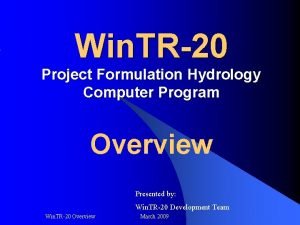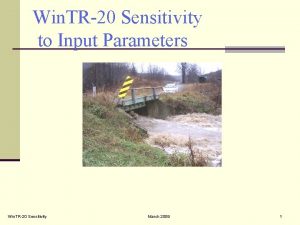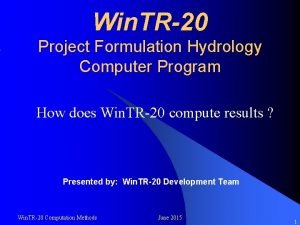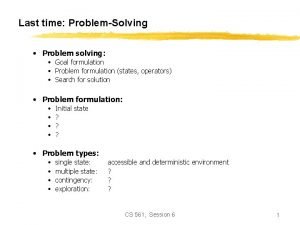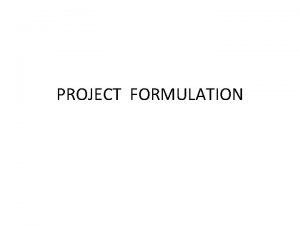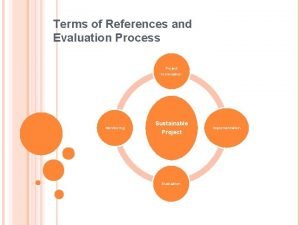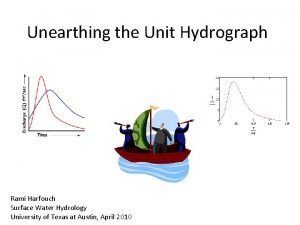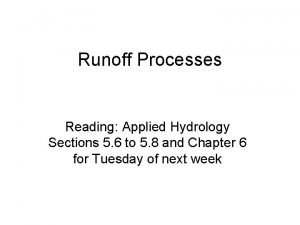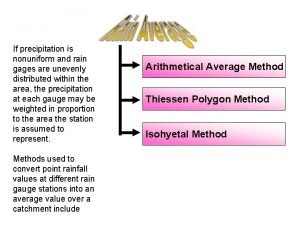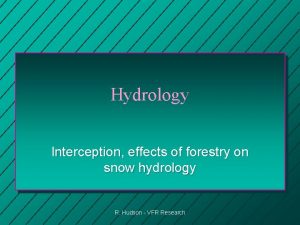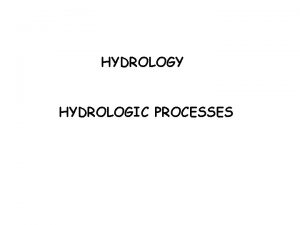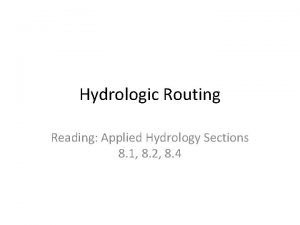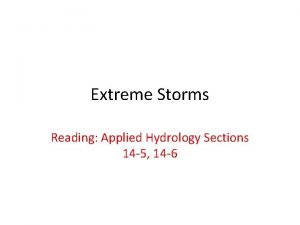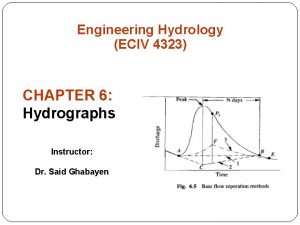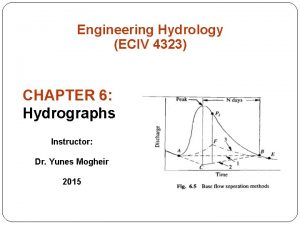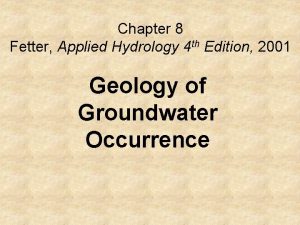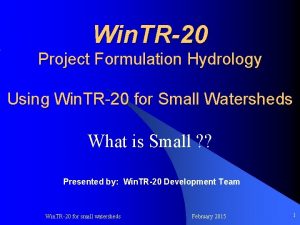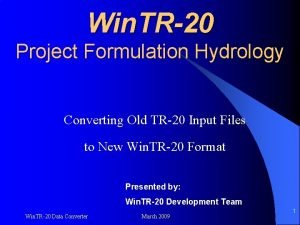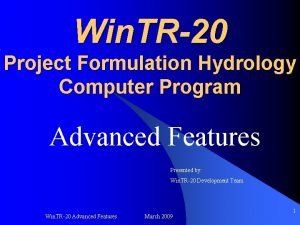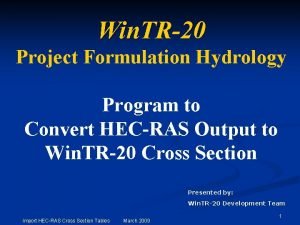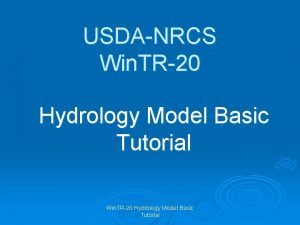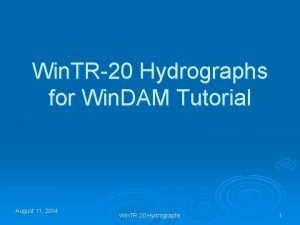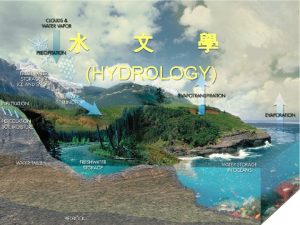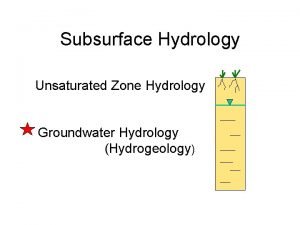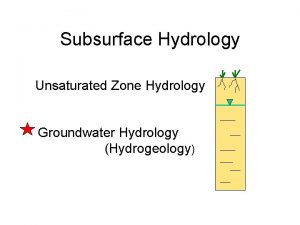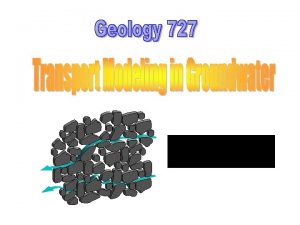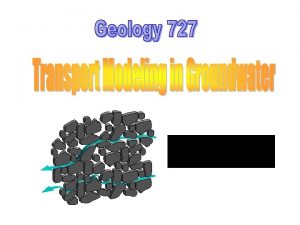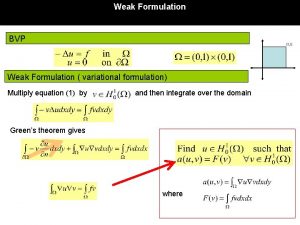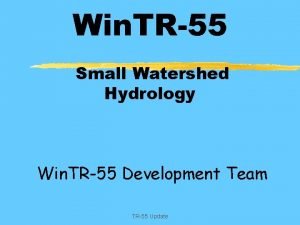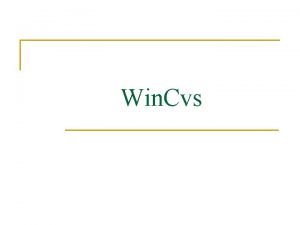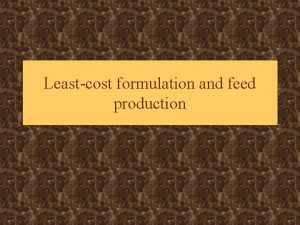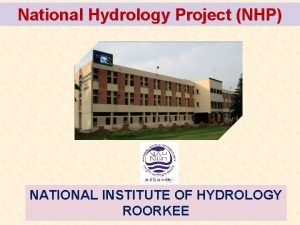Win TR20 Project Formulation Hydrology Computer Program How





































- Slides: 37

Win. TR-20 Project Formulation Hydrology Computer Program How does Win. TR-20 compute results ? Presented by: Win. TR-20 Development Team Win. TR-20 Computation Methods June 2015 1

Win. TR-20 Computation Differences l l l l Runoff hydrographs Time of Concentration Adjusting curve numbers Adding hydrographs Diverting or dividing hydrographs Structure Routing Reach Routing Smoothing NOAA Atlas 14 and NRCC data Win. TR-20 Computation Methods June 2015 2

Runoff Hydrographs l Win. TR-20 will compute runoff hydrographs according to NEH Part 630 Chapter 16 Hydrographs (2007). l The time increment used to develop the hydrograph is computed internally in Win. TR-20. l However, the user may set a time increment for output (interpolated values). Win. TR-20 Computation Methods June 2015 3

Runoff Hydrographs (cont) l To see the internal time increment in Win. TR-20, leave the Print Time Increment blank on the Global Output window. Win. TR-20 Computation Methods June 2015 4

Runoff Hydrographs(continued) The table above is the dimensionless unit hydrograph (DUH) with PRF 484. l The peak of the DUH is at point number 11. l Delta t = 0. 6 Tc / ((point number – 1) – 0. 5) l Delta t = 0. 063 Tc l Win. TR-20 Computation Methods June 2015 5

Runoff Hydrographs (cont) The table above the DUH for PRF 350. l The peak of the DUH is at point number 6. l Delta t = 0. 6 Tc / ((point number – 1) – 0. 5) l Delta t = 0. 133 Tc l Win. TR-20 Computation Methods June 2015 6

Calculating Time of Concentration (Tc) Besides direct entry of a Tc value, Win. TR-20 has two options for computing Tc. l Velocity Method for Tc from Win. TR-55 computer program. Uses sheet flow, shallow concentrated flow, and channel flow segments. l Lag Method for Tc calculation from EFH-2 computer program. Uses curve number, watershed length, and watershed slope. l Win. TR-20 Computation Methods June 2015 7

Velocity method for Tc Win. TR-20 Computation Methods June 2015 8

Calculating Sheet Flow Travel Time Win. TR-20 Computation Methods June 2015 9

Calculating Shallow Concentrated Flow Travel Time l Tt = Length (feet) / V (feet/sec) / 3600 (sec/hr) Win. TR-20 Computation Methods June 2015 10

Calculating Channel Flow Travel Time or Channel Velocity may be entered directly in data window. l Tt = Length (feet) / V (feet/sec) / 3600 (sec/hr) l Win. TR-20 Computation Methods June 2015 11

Lag Method for Tc Win. TR-20 Computation Methods June 2015 12

Lag Method for Tc Win. TR-20 Computation Methods June 2015 13

Viewing Tc calculations l Select Sub-Area Tc Computations. Tc calculations for each sub-area will be placed in the. dbg output file. Win. TR-20 Computation Methods June 2015 14

Viewing Tc calculations l From the View pull-down menu select Debug File. Win. TR-20 Computation Methods June 2015 15

Adjusting curve numbers Two methods have been added to Win. TR-20 to adjust the curve number of a sub-area. l One allows entry of an ARC value for a subarea (used in Texas and Kansas). l The second allows the user to reduce the curve number by a specific value for a subarea (used in Oklahoma). l These two methods are used to adjust curve number to calculate peak discharges for design of certain conservation practices. l Win. TR-20 Computation Methods June 2015 16

Adjust curve number by ARC may be any value from 1. 0 to 3. 0 l Original CN tables are based on ARC 2 l For example, adjust CN 80 from ARC 2 to ARC 1. 6 l If CN is 80 for ARC 2, then CN is 63 for ARC 1 l Use a linear interpolation to calculate CN 73. 2 for ARC 1. 6 l Win. TR-20 Computation Methods June 2015 17

Reduce curve number by specific value CN may be reduced by a number from 1 to 14. l For example, if the CN for ARC 2 is 78 and reduced by 8, Win. TR-20 will use a CN of 70 for this sub-area. l Win. TR-20 Computation Methods June 2015 18

Adding Hydrographs Two hydrographs may be combined or added such as where two streams join at a junction. l If the time intervals are the same, the discharges are added directly. l If time intervals are different (as they generally are) Win. TR-20 will combine hydrographs using the following method. l Win. TR-20 Computation Methods June 2015 19

Adding Hydrographs (cont) For example, let us add hydrographs A and B. l Hydrograph A has a time interval of 0. 1 hour and Hydrograph B has an interval of 0. 33 hour. l Hydrograph A is interpolated to a time interval of 0. 33 hour and added to Hydrograph B. l Hydrograph B is interpolated to an interval of 0. 1 hour and added to Hydrograph A. l Win. TR-20 Computation Methods June 2015 20

Adding Hydrographs (continued) l Whichever hydrograph has the higher peak is saved for further operations downstream. Win. TR-20 Computation Methods June 2015 21

Diverting or dividing hydrographs There are two methods of splitting a hydrograph in Win. TR-20. l Split based on two cross section rating curves. l Divert an inflow hydrograph above a specific discharge. l Win. TR-20 Computation Methods June 2015 22

Divide based on two rating curves Win. TR-20 Computation Methods June 2015 23

Divert above a specific discharge Win. TR-20 Computation Methods June 2015 24

Structure Routing l The storage indication method (described in NEH Part 630 Hydrology Chapter 17) is used to route the inflow hydrograph through the structure. Win. TR-20 Computation Methods June 2015 25

Maximum number of Hydrograph Points The maximum number is 100, 000. l This allows Win. TR-20 to save hydrographs at extremely short time intervals. l Sometimes with structure routings with very low release rates, this 100, 000 point limit can be exceeded. l Win. TR-20 Computation Methods June 2015 26

Channel Reach Routing The Muskingum-Cunge method is described in NEH Part 630 Chapter 17. Examples are provided. l Win. TR-20 training module 8 presents the Muskingum-Cunge method of routing. l Win. TR-20 Computation Methods June 2015 27

Smoothing NOAA 14 and NRCC Data When importing NOAA 14 or NRCC rainfall data there is an option to smooth the data. l The 60 -minute and 24 -hour precipitation values are not changed. Precipitation for other durations may be adjusted. l Smoothing the data provides for a smooth rainfall distribution and relatively smooth runoff hydrograph. l Win. TR-20 Computation Methods June 2015 28

Smoothing NOAA 14 and NRCC Data l Import and select Smooth option. From the View pull-down menu select Smoothed NOAA/NRCC File. Win. TR-20 Computation Methods June 2015 29

Smoothing NOAA 14 and NRCC Data This example is for the 25 -year return period NOAA 14 data at College Park, MD. l “Precip” is the original NOAA 14 data. l “Inc_Int” is the incremental intensity for the original NOAA 14 data. l The “Sm” refers to smoothed data. l Win. TR-20 Computation Methods June 2015 30

Smoothing NOAA 14 and NRCC Data Incremental Intensity is the difference in precipitation divided by the difference in duration converted to inches / hour. l At 5 -minute duration, l Win. TR-20 Computation Methods June 2015 31

Smoothing NOAA 14 and NRCC Data l At 30 minute duration, Win. TR-20 Computation Methods June 2015 32

Smoothing NOAA 14 and NRCC Data Incremental Intensity is the difference in precipitation divided by the difference in duration converted to inches / hour. l At 5 -minute duration, l l At 30 minute duration, Win. TR-20 Computation Methods June 2015 33

Smoothing NOAA 14 and NRCC Data l Smoothed Incremental Intensity. Win. TR-20 Computation Methods June 2015 34

Smoothing NOAA 14 and NRCC Data l Smoothed precipitation values. Win. TR-20 Computation Methods June 2015 35

The End Win. TR-20 Computation Methods June 2015 36

Win. TR-20 Computation Methods June 2015 37
 Win tr 20
Win tr 20 Win
Win Win tr20
Win tr20 Win tr 20
Win tr 20 Wintr20
Wintr20 Win tr20
Win tr20 Think win-win scenarios
Think win-win scenarios Win win win lose lose lose
Win win win lose lose lose Win win situacija
Win win situacija Why problem formulation follow goal formulation
Why problem formulation follow goal formulation Expand the pie
Expand the pie Winwin hesap
Winwin hesap Habit 4 think win-win examples
Habit 4 think win-win examples Habit 4 think win-win powerpoint
Habit 4 think win-win powerpoint Win-win conflict resolution
Win-win conflict resolution Win win strategies
Win win strategies Five dimensions of win win
Five dimensions of win win Win win nacin placanja
Win win nacin placanja Win win or no deal
Win win or no deal Program logic formulation
Program logic formulation Meaning of project formulation
Meaning of project formulation Project formulation and evaluation
Project formulation and evaluation Project formulation
Project formulation Applied hydrology
Applied hydrology Applied hydrology
Applied hydrology Meteorology hydrology and water management
Meteorology hydrology and water management Quadrant method hydrology
Quadrant method hydrology Hydrology test answers
Hydrology test answers Drh in hydrology
Drh in hydrology Interception hydrology
Interception hydrology Applied hydrology
Applied hydrology Hydrograph
Hydrograph Hyteograph
Hyteograph Applied hydrology
Applied hydrology The basic assumptions of unit hydrograph theory are
The basic assumptions of unit hydrograph theory are Drh in hydrology
Drh in hydrology Applied hydrology
Applied hydrology Continuity equation hydraulics
Continuity equation hydraulics
